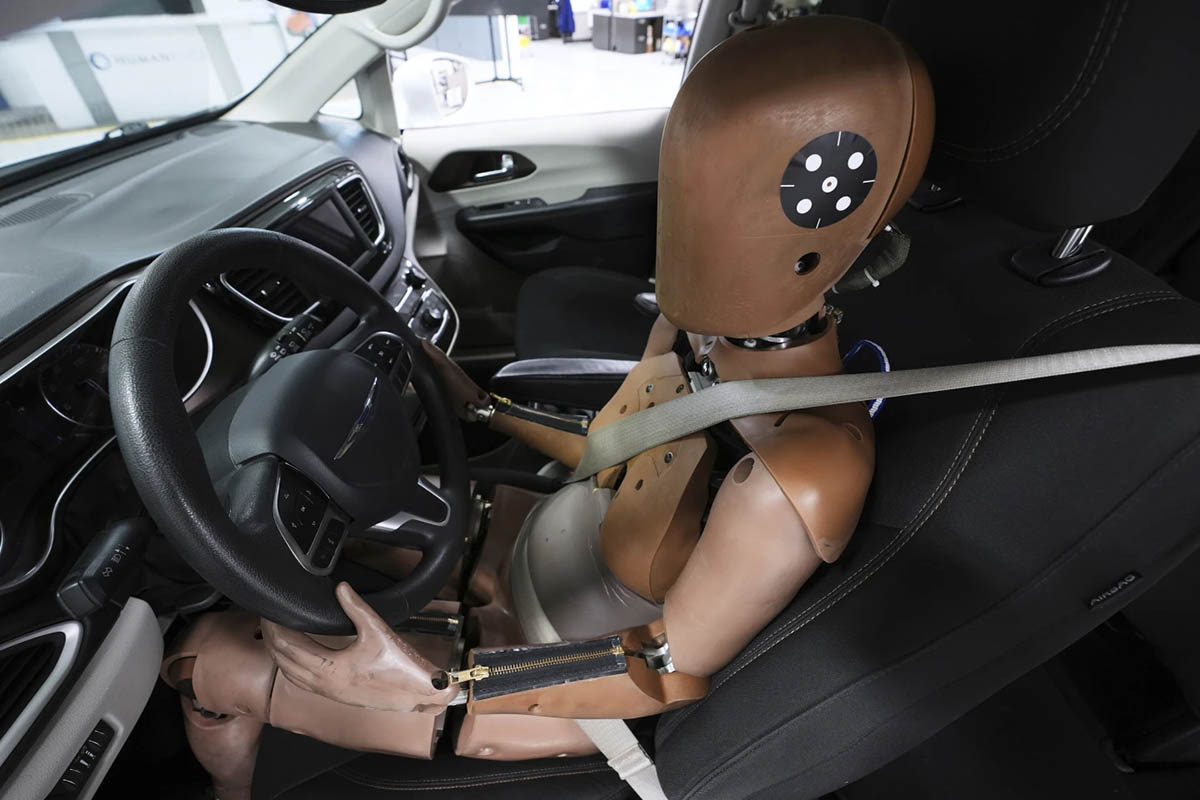
Maria Weston Kuhn had one lingering question about the car crash that forced her to undergo emergency surgery during a holiday in Ireland: why did she and her mother sustain serious injuries while her father and brother, who were in the front seats, emerged unscathed?
“It was a head-on crash and they were closest to the point of contact,” says Kuhn, now 25, who missed a term of university to recover from the 2019 collision that caused her seat belt to slip off her hips and rupture her intestines by pinning them against her spine. “That was an early clue that something else was going on.”
When Kuhn returned home to Maine, she discovered an article her grandmother had clipped from Consumer Reports and left on her bed. It revealed that women are 73% more likely to be injured in a frontal crash, yet the dummy used in vehicle tests by the National Highway Traffic Safety Administration dates back to the 1970s and is still modelled almost entirely on the body of a man.
A survivor becomes an activist
Kuhn, who is starting law school at New York University this autumn, founded the nonprofit Drive US Forward to raise awareness and urge Congress to pass a bill requiring NHTSA to incorporate a more advanced female dummy in its testing. The agency has the final say on which cars earn five-star safety ratings, and the dummy it uses can influence those results.
“It seems we have an easy solution where we can have crash-test dummies that reflect an average woman as well as a man,” says Senator Deb Fischer, a Nebraska Republican who has introduced the legislation in the past two sessions. Lawmakers from both parties back Fischer’s She Drives Act, and transportation secretaries from the past two administrations have expressed support for updated rules. Yet the push for new safety requirements in the US, where around 40,000 people die each year in road crashes, has so far been slow.
Evolution of a crash-test dummy
The dummy currently used in NHTSA’s five-star testing, known as the Hybrid III, was developed in 1978 and modelled on a 5 ft 9 in, 171 lb man—average size in the 1970s but about 29 lb lighter than today’s mean. The so-called female dummy is merely a smaller version of the male model with a rubber jacket to simulate breasts. It is tested mainly in passenger or rear seats, even though most licensed drivers are women.
“What they didn’t do is design a crash-test dummy with sensors in the areas where a woman would be injured differently from a man,” says Christopher O’Connor, president and CEO of Humanetics Group, which has spent more than a decade developing a more sophisticated female dummy. Humanetics’ version, equipped with all available sensors, costs around US $1 million—twice the price of the Hybrid III—but far more accurately reflects anatomical differences in neck, collarbone, pelvis and legs. An NHTSA study found that those differences account for about 80% more injuries to women in crashes compared with men.
Europe, China and Japan have already adopted Humanetics’ advanced male dummy, the THOR 50M, and its female counterpart, the THOR 5F, for safety testing. But some American carmakers remain sceptical, arguing that more complex devices may overstate injury risks and undermine the perceived value of safety features such as seat belts and airbags.
A debate over whether more sensors mean more safety
Bridget Walchesky, 19, was flown to hospital after a 2022 crash near her home in Sheboygan, Wisconsin, that killed her friend. Despite crediting her seat belt with saving her life, she believes some injuries—such as her broken collarbone—were worsened by the belt pinning her too tightly. “Seat belts aren’t really built for female bodies,” she says. “Better testing could improve that.”
The Alliance for Automotive Innovation, an industry trade group, tells the Associated Press that safety upgrades should come from enhancing the existing Hybrid III dummy rather than mandating a new one. “This can happen on a faster timeline and lead to quicker safety improvements than requiring NHTSA to adopt unproven crash-test dummy technology,” it states.
Humanetics’ THOR dummies performed well in early NHTSA tests using cadavers from real crashes, outperforming the Hybrid III in predicting head, neck, shoulder, abdomen and leg injuries. But an Insurance Institute for Highway Safety review found the male THOR less accurate than the Hybrid III at predicting chest injuries. “More isn’t necessarily better,” says Jessica Jermakian, IIHS senior vice-president for vehicle research. “You must be confident that the data reflects how a real person would fare.”
The slow pace of changing the rules
NHTSA’s budget plan includes developing the THOR 5F with the goal of integrating it into standard testing. But final approval for the THOR 50M is still pending in the US. A 2023 Government Accountability Office report cited numerous “missed milestones” in NHTSA’s crash-dummy enhancements, including the THOR series.
Kuhn concedes she is frustrated by the slow regulatory process but remains hopeful. “Fortunately, automakers have very skilled engineers and they’ll figure it out,” she says.
By RSS/AP






